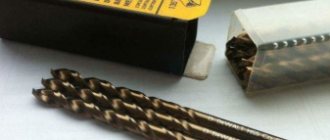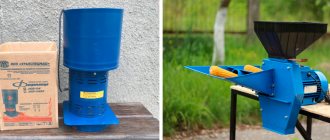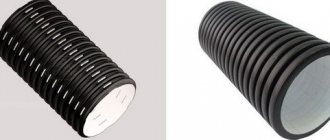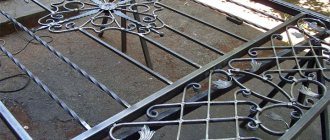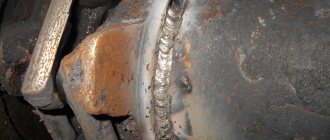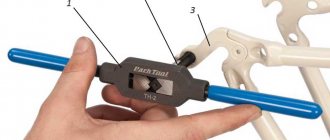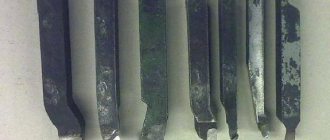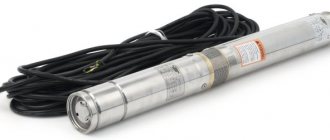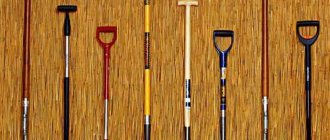Chemical composition and characteristics
Depending on the alloying elements, HSS steels are divided into three main groups:
- T – high tungsten content.
- M – molybdenum is used for alloying.
- Highly doped group.
Analogues of domestic steel grades are R18, R6M5 and other R alloys, widely used for the manufacture of tools.
HSS steels with high tungsten content are rarely used due to their high cost. The most widely used grades are T1 and T15, the first refers to general-purpose alloys, the second, in addition to tungsten, contains vanadium and cobalt, which provides high resistance to wear and operation at high temperatures.
Group M steels are more affordable and, accordingly, more common in modern metalworking. In addition to molybdenum, vanadium, cobalt and tungsten can be used for alloying, which provides high resistance to abrasive wear. In the manufacture of tools with high requirements for temperature resistance, steel grades starting from M41 are used.
Features of heat treatment
The result of high-temperature processing of high-speed steels is a change in the structure of the material to obtain certain physical and mechanical properties required when working with this tool.
Annealing
HSS steel after the rolling and forging process acquires increased hardness and internal stress. In this regard, the workpieces are preliminarily annealed. Annealing relieves the internal stress of the material, improves machinability and prepares it for hardening.
The annealing process occurs at a temperature of about 850-900°C. However, one should be wary of excessively increasing the temperature and duration of exposure, because this may cause the steel to become more hard. Due to the reduced thermal conductivity of the alloy, heating is carried out slowly and evenly.
The products are loaded into the oven at a temperature of 200-300oC, while subsequent heating is increased at a rate of 150-200o/hour. The process ends with slow cooling: first in an oven to 650 ° C, and then to room temperature in the open air.
To protect against decarburization, annealing is carried out in closed boxes with a neutral environment.
Machine-building plants subject a small number of workpieces to isothermal annealing. They are heated to 880-900oC for a short time, and then transferred to an oven with a temperature not higher than 720-730oC for 2-3 hours. To protect against the appearance of excessive internal stresses, the workpieces are cooled in an oven to 400-450°C and then left in the open air.
Conventional annealing takes longer than the isothermal process. Subsequently, the workpieces undergo mechanical processing, and then the tool undergoes the final heat treatment process - hardening and tempering.
Hardening
Tools made of high-speed steel are hardened at temperatures above 1300°C. After the hardening process, repeated tempering occurs at 550-560°C. This temperature is necessary to dissolve a large number of carbides in the austenite to obtain highly alloyed austenite.
With further cooling, highly alloyed martensite is obtained, which contains large amounts of tungsten, vanadium and chromium. Martensite does not disintegrate when heated to 600°C, which gives high-speed steel red-hardness.
To obtain high red-hardness values, the temperature during hardening must be very high. However, there is a limit, when exceeded, rapid grain growth begins in high-speed steel and melting occurs.
Steel grades
When choosing a tool made from HSS steels, it is necessary to take into account the characteristics of individual steel grades. Thus, drills for widespread use are most often made of M1 steel, which is characterized by high flexibility and resistance to impact loads. But in terms of red resistance, this alloy is inferior to M2, which is used for the manufacture of a wide range of tools for various purposes intended for use in machine tools. This alloy is characterized by high abrasion resistance of cutting edges and good resistance to high temperatures.
For large drills subjected to high loads, M7 alloy is most suitable, characterized by high flexibility and reliability. The tool made from it is excellent for drilling holes in hard materials.
The following steel grades of the HSS group are also widely used:
- M50 is a flexible alloy used for tools designed to work with hand-held power tools. Inferior to other brands in temperature resistance.
- M35 is an HSSE alloy with a high cobalt content and high resistance to temperature load, exceeding M2 in this indicator. The disadvantage is reduced resistance to impact loads.
- M42 is an alloy with a maximum cobalt content, which provides high red-hardness and resistance to abrasive wear. Excellent for working with viscous and hard materials.
How do HSS drills differ from carbide models?
First of all, HSS drills differ from carbide drills in their material manufacturing technology.
- High-speed steel is produced by adding tungsten, chromium, molybdenum and other components to carbon steel. The material of HSS drills is highly durable.
- Carbide is a composite material made using powder metallurgy technology. It consists of micron-sized particles. The main component is tungsten carbide. Additional ones include titanium carbide, tantalum carbide, etc.
Carbide tools from HSS drills are characterized by higher hardness and heat resistance. However, hard alloys have lower strength. They are afraid of vibrations and force loads. This does not allow the use of carbide drills for intermittent machining of workpieces at high speeds.
Due to the complex manufacturing technology, carbide tools are expensive. Prices for drills made of high-speed steel are much lower.
This is interesting: Stainless steel grades - classification, decoding
Legend
The chemical composition of HSS steel grades is not indicated in the marking and is available only in the catalog. But there are symbols for groups of materials that you can focus on when selecting a tool:
- HSS or HSS R. The least resistant material subjected to heat treatment.
- HSS G is a tool ground with Borazon with high durability.
- HSS E is an alloy containing cobalt. Suitable for processing viscous and hard materials.
- HSS G TiN is a tool coated with titanium nitride.
HSS steels are widely used in modern metalworking for tools of various types, primarily due to the optimal combination of price and quality.
Area of application of high-speed steels
The composition of the material determines the application and performance characteristics. Tools made from this metal can withstand long-term use.
HSS steel is used:
- for the production of drills with complex shapes and designs obtained by casting;
- in the production of cutting edges of cutters to increase wear resistance;
- for forming cutting tool tips;
- for the manufacture of cutters, countersinks, taps, dies, knives or saw blades.
Tips for choosing
To choose the right drill, you need to pay attention to important points.
- Study the characteristics of the material and the capabilities of the drill so that the tool meets the requirements of the work being performed.
- Look at the color of the product. It can talk about how the metal was processed.
- steel color indicates that no heat treatment was performed;
- yellow – the metal has been processed, internal stress in the material has been eliminated;
- a bright golden shade indicates the presence of titanium nitride, which increases wear resistance;
- black – the metal is processed with hot steam.
- Study the markings to find out the type of steel, diameter, hardness.
- Find out about the manufacturer, consult with specialists.
- Study the issue of tool sharpening.
Often drills are sold in sets, for example, with different diameters. The question of purchasing such a tool requires an understanding of what purposes the drill is required for and how many options can be used.
Foreign marking of HSS drills
As we noted above, the HSS marking means that the metal drill is made of high-speed steel. Foreign tool manufacturers add various additional designations that indicate the technologies used and other features. Let's talk about the markings of common HSS drills.
The following factors directly influence the choice of HSS drills.
- Grade of processed steel. The choice of tool based on the material of manufacture depends on it.
- Equipment that needs to be equipped with a drill. Buy drill bits with shanks that fit the equipment you have.
- Frequency of use. If you are looking for an HSS drill for one-time jobs, inexpensive models are suitable. If you use the tool often, do not skimp on quality.
You will find detailed information about choosing metal drills for various jobs in this article (put a link to the page with article No. 1).
and1111
15-12-2009 19:12
Hello community! Well, I got a scrap of a jointer knife from this. I know that quick-cut steel is with tungsten, but whether it is suitable for a blade, whether the tail can be welded to it, how, whether it rusts badly - I don’t know anything. I tried to ask the sergeant via PM, since there are already enough topics about metal here, but the Hansa are in their repertoire...
AAAAA
15-12-2009 19:26
p18. I really liked the wedge from this. and not for everybody.
Borz87
15-12-2009 19:44
Yesterday I also saw it in the store, I’m thinking whether to take it or not, a short 200mm one costs 400 rubles, a long one about a meter costs more than a thousand, and sometimes people ask for fast rubber - they’ve finished the cutters, you’ll spend half a day while you grind a strip out of it.. by the way, there’s no zone hardening, Hope?
Udod
15-12-2009 20:15
Even as a child, my P18 blade split into three parts (although it was thrown at a fence.) And in my student years, a friend on a hike had several pieces broken out of the cutting edge. In general, it is the most fragile of all quick cutters, but it cuts well.
and1111
15-12-2009 20:52
yeah. suitable. I’m not going to throw and chop, I’m completely hardened. I’ve long wanted to make a knife for dear Andrei Vasilich from good carbon, I’m tired of stainless soap. I want it to - whack! won't the tail bounce off from the welding? Or do I need to warm it up first? Is it possible to re-harden it?
sheb
15-12-2009 21:08
Why did you decide that this is P18? For example, I have “FABA” knives on my machine, it also says HSS18%W, they plan great, but I tried a super-soapy cut for the knife and threw it in the trash.
Knife maker
15-12-2009 21:09
I've been working with P18 for over a year now. Excellent steel!! But I forge it onto blades from an 18mm square.
Boil the tail?! I won’t say anything because I haven’t tried it!
Overheat? There the temperature needed is about 1250-1280C. Without experience and experiments, nothing good will come of it.
And so, you can cut it out of a plane knife. But don't expect anything special.
dblsav
15-12-2009 21:49
I made a knife from this steel. I won’t say that the cut is excellent, but I won’t say that it’s super soapy. It won’t stand up to “guy tests” under zero pressure and will crumble. A ten-day fishing knife plowed honestly. There is an opinion that knives made from this steel should be sharpened not as usual, but without polishing the steel. Good luck.
sheb
15-12-2009 22:02
quote: There is an opinion that knives made from this steel should be sharpened not as usual, but without polishing the steel.
Like it should be not a micro saw, but a macro saw?
dblsav
15-12-2009 22:10
quote: Originally posted by sheb: Like, not a micro saw, but a macro saw?
“Sort of yes”…. diamond 20-40 microns and good.
beard-fish
16-12-2009 12:21
quote: “Sort of yes”…. diamond 20-40 microns and good.
I agree, for some reason on P18 and P9 the correction after the diamond “20” with a “five” shaves better, but the cut is not childishly soapy... and polishing with a “one” generally spoils the cut and why is it considered that HSS is 18%W -is this p18?
—————— Sincerely, BeardedRyb
anatoly
16-12-2009 04:32
quote: why is it considered that HSS 18%W is p18?
Because P18 also contains 18% tungsten.
I made a knife out of it, I still have a piece at home. Didn't cause any admiration, but that's okay. I made descents to zero with a width of 4 cm and a thickness of 3 mm. They do not crumble. The cut is so-so. It quickly loses its razor sharpness, but the residual edge cuts for a long time. As they say, “it chops well, but it cuts not very well.” Welding something simply won’t work. It’s better to cut it out like a dovetail, or make a cut with a grinder and rivet the pin. Sincerely, December
16-12-2009 12:58
If the knife is from a jointer, then it’s 8x6nft; you can’t imagine a better steel for a knife. It rusts slightly, hardness is 56-58, is not afraid of burns on sandpaper (within reasonable limits), is easy to sharpen, cuts wonderfully, can be welded.
chief
16-12-2009 13:03
I’m not too lazy to write everywhere - soldering the tail with silver or brass is easier for me than cooking, because it’s at home, in the kitchen...
GAU-8A
16-12-2009 13:24
Everything can be welded with argon, stainless steel shanks were welded to 90V, to Japanese CV134, to Petrikovsky cermets.
sm special
16-12-2009 13:37
quote: Originally posted by and1111: ..., is it possible to weld a tail to it, with what...
From the “Brand of Steels and Alloys” about P18: weldability is good for electric butt welding with steels 45 and 40X.
From theory: P18 has a very heterogeneous structure and is significantly inferior to P3M5 in terms of quality indicators. and1111
16-12-2009 14:48
I tried it on sandpaper: rare small dark sparks.
anatoly
16-12-2009 17:33
quote: If the knife is from a jointer, then it is 8x6nft
But there is no 18% tungsten there.
It cooks well when it’s tempered, but for some reason it doesn’t want to when it’s hardened. At least our welders couldn’t weld it. It seems that welders are not bad either. It tears after welding and right along the seam. Maybe the seam needs to be heated, or it needs to cool slowly. Well, in general, it didn’t work out for us then.
Threat 18% tungsten cannot be stuffed into any composition so easily. In general, it should be an analogue of P18, but if you looked at the brand manual, then there are jumps up to 0.2 percent in carbon, chromium - up to 1, etc. and all this is within the limits of the state standard, so that there is probably no need to talk about an analogue even from heat to heat. Then I noticed that the quick cutter cuts better at lower hardnesses (around 50-55) (My IMHO), at 57-58 - which is exactly the hardness of woodworking knives, it cuts worse. All imha, of course. Sincerely
and1111
16-12-2009 19:54
here is comrade. The sergeant is a fan of fast-cutting weapons, but maintains some neutrality. but he knows exactly what can come out of this piece of iron. Well, to prevent vomiting during welding, you must first heat it with gas. I just need to lengthen the tail, the blade will not be damaged.
The abbreviation HSS, made up of the initial letters of the English words High Speed Steel, denotes a whole group of steels classified as high-speed. Milling cutters, taps, and dies for thread cutting are made from steels of this type. Much less often, such material is used for the production of hacksaw blades and knives.
Alloys of the HSS category refer to those, some grades of which may contain a significant amount of tungsten. The hardness of a tool made from this type of steel can be in the range of 62–64 units on the HRC scale.
End mill made of HSS-Co8 steel is capable of processing material with a tensile strength of up to 1100N/mm2
Tools made from HSS steels, when compared with carbide steels, are more affordable and have higher strength, which allows them to be successfully used for interrupted cutting. Meanwhile, processing with their help is allowed at lower cutting speeds when compared with carbide drills.
The composition, which foreign manufacturers call alloys of the HSS category, has been constantly improved. So, from the end of the 19th century, a significant amount of tungsten began to be added to such steels (up to 18%), and from 1912 cobalt began to appear in these alloys. It was only in 1930 that molybdenum was included in HSS steels.
